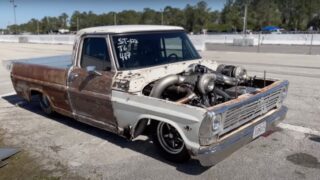’91 F-Series: Porting and polishing 5.0L intake and heads (F7TE)
By Bob Schreiber
This how-to was written to help the do-it-yourselfer. Please note that this is intended to explain the process and what worked for me. Your results may vary based on your skill level and end results desired. Please note that improper porting will end up wrecking your heads or worse, your engine. It is assumed that you have a moderate understanding of engine basics, and disassembly.
This project started off as just an investigation as to why I was leaking trace amounts of oil and coolant. I figured it was a blown head gasket and after disassembly, I was right. While I had the engine party torn down, I figured I’d go ahead and port / polish up the heads to gain a bit of efficiency and more HP along the way as well.
Tools needed:
-Assorted screwdrivers, both flat head and Philips.
-Socket set
-Socket extensions
-Breaker bar
-Torque wrench
-Valve spring tool
-Fuel disconnect tool
-Variable speed Dremel or die grinder with a flexible extension
-Carbide burrs for your rotary tool, ball and flame are recommended
-Grinding stones
-Sanding drums (60 and 120 grit) and flapper wheels (120 grit)
-Paper towels
-Rags
-Anti-seize
-Drain tube for radiator (approx 3′ of 3/8″ ID hose)
-Oil pans
-Several cans of carb cleaner (I used about 7-8 cans)
-Engine oil (for threads and an oil change after assembly)
-Antifreeze (two gallons to mix up after reassembly)
-Notepad & pen
-Sharpie marker
-Masking tape
-Zip-Loc bags
-New gasket set
First off, if you have ever taken on a project of this size before, you know it is imperative that you take notes documenting your steps. Use the masking tape and label all vacuum hoses, electrical connections, bolts, bags, and anything that you feel need to be labeled to ease reassembly. Trust me, this will save you time. You may even want to take pictures as you go to have a visual reference.
Since this article revolves around the portwork, I’ll skip over the disassembly of the majority of the engine’s components and electrical system. You can reference on-line articles as well as a Haynes or Chilton manual. I would still recommend that you have a manual if nothing else for the torque specs for reassembly. Also, don’t forget to depressurize the fuel system and disconnect the battery before engine disassembly.
Once you have some of the engine components removed and have a clear view of the plenum, throttle body, and intake manifold, be sure to blow out the engine compartment so that no dirt, grime, sand or any foreign material is around to fall into the engine during disassembly. Also plug any orifice with paper towels or rags to prevent moisture and spiders from taking up residence in your engine. At this point you should have something like this:

Now my truck is a 91′ and has ~145K miles at the time of this project. If you have a similar situation, expect tons of carbon build up as seen here in the plenum and intake:


You can also see the ring where the stock gasket was. You can see potential for some material to be removed if that is what you are after. Here is the intake side on the head:

With the heads and intake out, you want to clean them up as best you can with carb cleaner and a toothbrush and or a wire brush. If you use bristle brushes, stick with brass or nylon, as they won’t harm the surface. Be sure to get the intake & exhaust runners as well as the combustion chamber. You may want to attack the coolant passages if you aren’t planning on taking it to a shop and hot-tanking it.
Remove the valves, springs, and retainers and make sure to keep them in order. I used Ziploc bags to keep everything separated and organized. Make sure you have ample lighting. You will also need safety glasses as the carbide burrs will fling metal everywhere and you don’t want it in your eyes. You will need cutting oil (or regular engine oil) if you are doing cast iron, as heat is the enemy of your burr. Now grab your sharpie and gasket it’s time to mark out where we will be grinding. Using the Sharpie marker, color around the ports, and then put the gasket into place. Using a scratch awl, nail, or screw, scribe a line along the inside of the gasket. We now have our guidelines for a gasket match. Now create a bevel around the port you are working on at ~45 degrees bringing it down almost to the scribe line. Do this with a carbide burr. From there you can continue to slowly grind away coming down to just above the scribe line. I focused on a port match, tapering from about 2″ deep in the port and smoothing from there. After you have done your major shaping with the carbide burr(s) switch to your grinding stones for further refinement. If you are porting the intake side, stop here. If you polish the long intake runner of these heads, you run a risk of letting fuel pool in the runner. The slight roughness will keep a bit of turbulence in the runner and allow the fuel to stay airborne. If you are porting the exhaust side, move on to 60 grit sanding drums, then 120 grit, then onto the 120 grit flapper wheel. Once done with the flapper, you should have a near-mirror finish. Now on to the bowl work.
Because the valve guides are cast in and are not inserts, it is important to leave at least 1/8th of an inch around for proper support. You can either bring it down to this measurement to form a tapered cone, or you can knife edge the runner side for better flow. Because my application isn’t for race, I decided to do a conical finish and not the knife edge. As you are grinding, be careful around your valve seats. You can blend the base of the seat into the bowl, but don’t touch the seat anywhere near the stock 45 degree bevel. As you are grinding, use your finger to feel the shape of the port and smooth as you see fit. Be careful on the short turn side as there will be a coolant passage underneath. If you grind away too much material, you will have a costly repair or head replacement. With these guidelines in mind, shape with the carbide burrs, fine tune with the grinding stones, then finish with sanding drums and flapper wheels. Again if you are in an intake runner, skip the finish sanding steps.
Here are some before and after examples:





Now that you have the runners done, you can focus on the combustion chamber. We want to get rid of any sharp edges and polish the chamber to prevent detonation and stop carbon buildup. As before, shape with carbides, then grinding stones, then sanding drums and flapper wheels.

From here, I took the heads to a local shop for a valve job, and to get cleaned. I had the seals replaced as well as the heads decked. This took about a week so I decided to port the intake, throttle body and remove the restrictive air horns in the intake tubing. I removed the steps in the throttle body and removed the casting roughness in the intake.


And after I got the heads back from the shop, they looked new again.



Before you start reassembly, chase all of your threads with a bolt. Score the threads with a cut off wheel so any debris in the hole collects there. Then blow the hole out with a compressor.

Follow the torque specs to the tee during reassembly. At this point it would be a good idea to replace your fuel and air filters. Before you start up the engine, make sure you have all new fluids and that you have triple checked your fuel connections. Also make sure your battery is fully charged. Prime the system and you should be good to go. Mine turned over 5 or 6 times and fired right up. I have noticed about a 10% gain in mileage and better throttle response.




